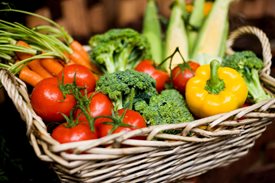The term ‘organic’ can be confusing. While many of us have seen organic produce in the supermarkets, do you know what it is that makes crops organic?
For food to be organic, the growing process must not use any synthetic chemicals, including pesticides or fertilisers, and production should be environmentally sustainable.
Feeling a little confused? You may well be! While this sounds complicated, organic gardening is probably easier than you think.
Organic Gardening: Grow Organic Vegetables
 Eating organic vegetables can have many benefits for you and your family, such as reducing the amount of pesticides you consume. The problem is, buying organic can be so expensive! However, growing your own is a much cheaper alternative and means you have home-grown produce right on your doorstep.
Eating organic vegetables can have many benefits for you and your family, such as reducing the amount of pesticides you consume. The problem is, buying organic can be so expensive! However, growing your own is a much cheaper alternative and means you have home-grown produce right on your doorstep.
Whether you have a large garden or a small backyard, you can grow organic fruit and veg on any scale. Here’s how you can improve your family’s diet and experience the joy of growing your own veg.
How to Start an Organic Vegetable Garden in Your Backyard
The first step to growing organically is allocating a spot for your vegetable garden. This should be an area that receives lots of sunlight, with little shade and which is sheltered from the wind. A warm, sunny and sheltered area provides the best environment for fruits and vegetables, helping to produce bigger crops.
Next, it’s time to prepare the soil. This is important because the better the condition of the soil, the better the crops it will produce. To do this, use a pH testing kit – This will analyse the nutrient levels and assess the health of the soil. You can then use this RHS guide to make your own compost and improve the condition of your vegetable patch.
 How to Plant Organic Vegetables
How to Plant Organic Vegetables
Planting an organic garden requires a little more thought than a standard vegetable patch. This is because it must be carefully planned in order to make the most of nutrients, space and the number of crops produced.
One way to do this is by using the companion planting approach – This means choosing fruits and vegetables that are known to work well together, which boosts nutrients in the soil and results in better produce – like the pairings on this chart.
Also think about how you can make the most of this space by choosing plants that are harvested at different times of the year. This allows you to fully utilise your patch and provide your family with more delicious organic fruit and veg.
How to Maintain an Organic Vegetable Garden
To get lots of high quality fruits and vegetables, it’s important to maintain your organic garden. There are three ways to do this – watering, removing weeds, and using natural pesticides.
To get the best results, water your patch in the morning or early evening when there’s less sun to evaporate water. Avoid watering later at night when temperatures drop, as the soil will remain wet and increase the risk of disease.
When removing weeds in an organic garden, this must be done naturally, without the use of chemicals. The best way is to pull out the weeds by hand. While this can be time consuming, it keeps your patch in peak condition.
Lastly, you want to make sure your fruits and vegetables are not damaged by insects. There are several ways to do this, including using nets, natural pesticides like garlic spray, and encouraging predators, such as frogs, birds and spiders.
Choosing to grow organic can have lots of benefits for you and your family, such as helping the environment, better tasting vegetables, and reducing your food bill. So, use this organic gardening guide to get started and consider a polytunnel to help you produce fresh fruit and veg all year.